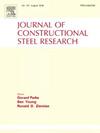Experimental and theoretical research on innovative prefabricated artificial plastic hinge joints
IF 4
2区 工程技术
Q1 CONSTRUCTION & BUILDING TECHNOLOGY
引用次数: 0
Abstract
To address the challenges of limited seismic toughness and complex construction in beam-column joints of prefabricated frame structures, this study introduces innovative artificial plastic hinge joints (HJs). Quasi-static tests were conducted to examine the failure modes, strain distribution, and hysteresis behavior of HJs. The impact of replaceable buckling connection plates (RBCPs) and shear energy dissipation rods (SEDRs) on seismic performance was analyzed, focusing on thickness, strength, and diameter. A stress mechanism for HJs was proposed, and a formula for bending capacity was derived and validated. The results indicate that HJs fail due to beam rotation around the pin, RBCP buckling under compression, and SEDR shear failure. HJs exhibited excellent seismic performance, with ductility coefficients ranging from 3.93 to 8.40 and equivalent viscous damping coefficients between 0.25 and 0.40. The validated finite element model reliably simulates the seismic behavior of HJs, accurately capturing their failure modes, load-bearing capacity, and energy dissipation characteristics. Increased RBCPs thickness and strength significantly enhanced bearing capacity and initial stiffness, while larger SEDRs diameters improved post-yield capacity. The sequential buckling and shear failure of RBCPs and SEDRs effectively function as dual “fuses,” ensuring reliable force transmission.
The theoretical formula accurately predicts the bending capacity of HJs.
求助全文
约1分钟内获得全文
求助全文
来源期刊

Journal of Constructional Steel Research
工程技术-工程:土木
CiteScore
7.90
自引率
19.50%
发文量
550
审稿时长
46 days
期刊介绍:
The Journal of Constructional Steel Research provides an international forum for the presentation and discussion of the latest developments in structural steel research and their applications. It is aimed not only at researchers but also at those likely to be most affected by research results, i.e. designers and fabricators. Original papers of a high standard dealing with all aspects of steel research including theoretical and experimental research on elements, assemblages, connection and material properties are considered for publication.
 求助内容:
求助内容: 应助结果提醒方式:
应助结果提醒方式:


